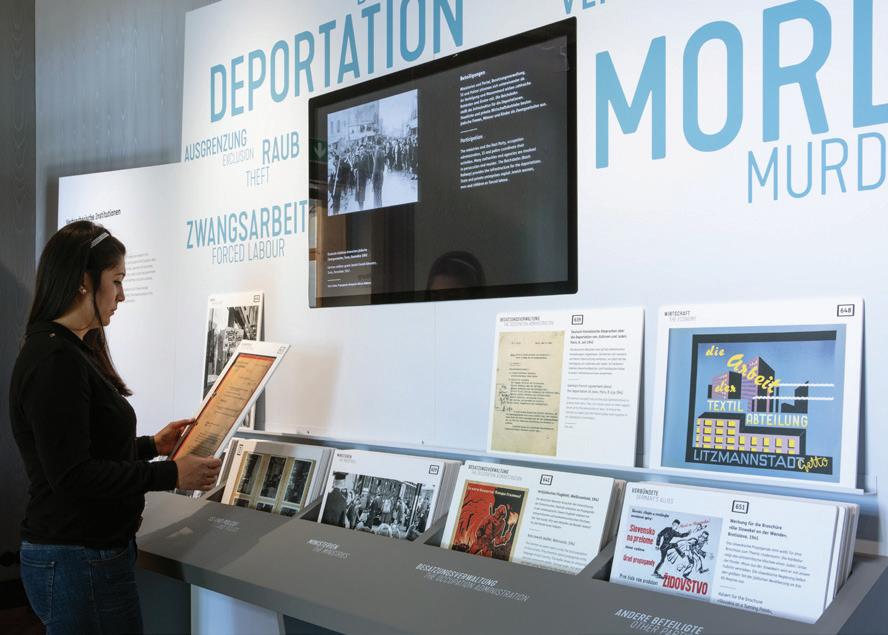
18 minute read
The Conversation
TO JOIN THE CONVERSATION:
• RESPOND AT MOMENTMAG.COM • TWEET @MOMENTMAGAZINE • COMMENT ON FACEBOOK • SEND A LETTER TO THE EDITOR TO EDITOR@MOMENTMAG.COM
Please include your hometown, state, email and phone number. Moment reserves the right to edit letters for clarity and space.
HOLOCAUST EDUCATION
WE NEED MORE TEACHERS Thank you for this excellent article (“The State of Holocaust Education in America,” Winter 2022). It is 50 years since Holocaust education was established. Society was ready to ask: How did this happen? Why did it happen?
When survivors like me come to schools to tell our courageous stories of survival, students are deeply touched. With the loss of survivors, teachers can still show films of testimony. And fortunately, there are family members of survivors who speak about their parents, using memorabilia, film and interviews.
But teachers are overwhelmed with responsibilities. They are asked to teach required subjects but also to mold character and citizenship, stop hate and help students develop empathy. The act of legislating Holocaust education doesn’t mean that it will be taught well or correctly. There are plenty of examples of ignorance by administrators, members of Boards of Education and teachers.
The teachers who choose to study and teach about the Holocaust are very much needed, especially at this challenging time in history. A special thanks for your hard work to make this a better world for our children and future generations. Peppy Margolis Galloway, NJ
CHALLENGES WE FACE An important aspect of Dan Freedman’s excellent article is its recognition and concern regarding the difficulty of measuring the degree of learning that occurs as a result of Holocaust education in our schools. The development of effective and reliable methods and instruments to assess what students are learning is complex because of numerous factors: the wide disparity between what different schools teach; how much time is devoted to instruction on the Holocaust and the lacking knowledge base of teachers who have not studied this subject thoroughly themselves. Compounding the challenge is the unintended impact of state testing, which for several decades has placed greater emphasis on reading, writing and mathematics. In many schools, this has resulted in less time and fewer resources devoted to the teaching of social studies, where lessons on the Holocaust are normally taught. Since formal education must play a key role in assuring that future generations attain knowledge of the Holocaust and keep its memory alive, we must continue to build upon the impressive foundation that has been established. Richard Flaim The Villages, FL
LESSONS LEARNED The extensiveness of this article, buttressed by its in-depth research, will make it a fascinating piece for quite some time to come. I was one of many involved in the development of California’s Holocaust education curriculum. It was well over ten years between the legislative approval of California’s mandate in 1985 and the start of widespread teaching about the Holocaust in classrooms. The lesson we learned is that without a legion of educators and advocates devoted to this subject, the words of any state’s mandates are meaningless. I hope that our experience truly will help state leaders and teachers devise meaningful Holocaust teaching mandates. These are a few issues we struggled with in California: • How best to determine “age-appropriate” instruction. • How best to integrate within schools’ curricula—within specific subjects or, perhaps, even across core subjects. • How (if at all) to fund teacher trainings, including in-person
and/or electronic—and whether via colleges, Holocaust centers/ museums, professional subject-matter organizations or by other means. • How to teach about the Holocaust in a world in which we continue to struggle with threats and acts of genocide. • How to align a state’s mandate with the federal Never Again Education Act, approved by Congress in 2020.
Perhaps most importantly, states and schools must learn how best to utilize the expansive educational resources at the United States Holocaust Memorial Museum. William Younglove Lakewood, CA
“IT” CAN HAPPEN HERE I appreciate Dan Freedman’s very thorough article. When my colleagues and I developed one of the first instructional units on Holocaust education for high school students back in 1972—which Freedman cites—we were anxious to see this vital subject taught in high schools all over the country.
Yet, despite the fact that events—both here and abroad—continue to make it strikingly clear that “it” can happen here, I fear that far too many high school students still don’t have the opportunity to learn about the subject.
My research on teaching about the Holocaust has revealed that when students learn about the causes of prejudice—and how such attitudes can lead to genocidal behavior—many shed their own prejudices. Put simply, Holocaust education can open young minds. Roselle Kline Chartock Great Barrington, MA
FROM THE EDITOR-IN-CHIEF
A NORTH STAR Nadine Epstein’s beautiful and deeply moving essay (“Elie Wiesel and Two Girls He Never Met,” Winter 2022) has an important message. It reminds us all how crucial it is to remember and share the horrific and unthinkable history of
No charitable gift has a greater impact on the lives of Israelis.
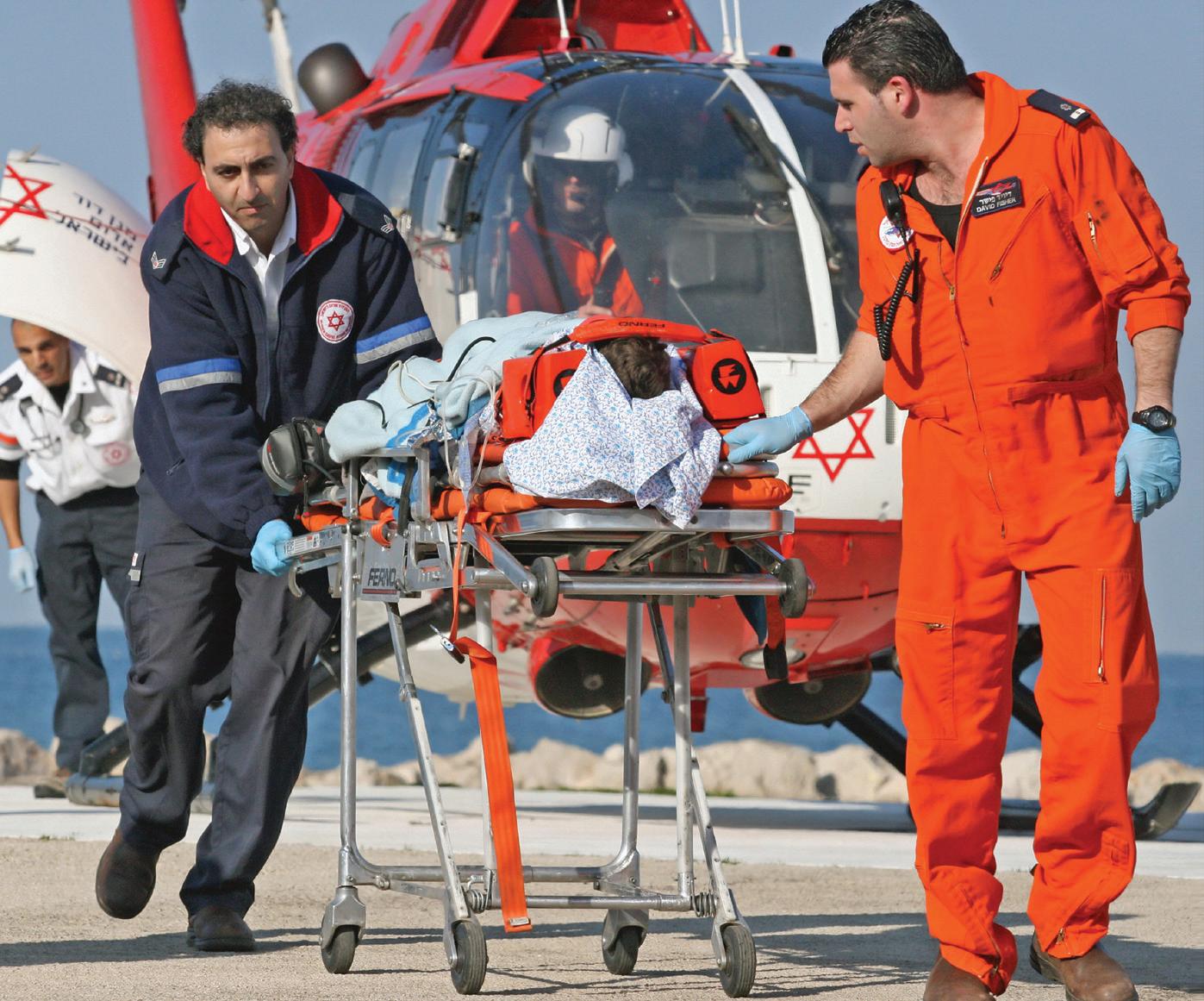
There are many ways to support Israel and its people, but none is more transformative than a gift to Magen David Adom, Israel’s paramedic and Red Cross service. Your gift to MDA isn’t just changing lives — it’s literally saving them — providing critical care and hospital transport for everyone from victims of heart attacks to casualties of rocket attacks.
Save a life through a gift to Magen David Adom today. Support MDA by visiting AFMDA.org/give or calling 866.632.2763.
SUBSCRIBE TO MOMENT

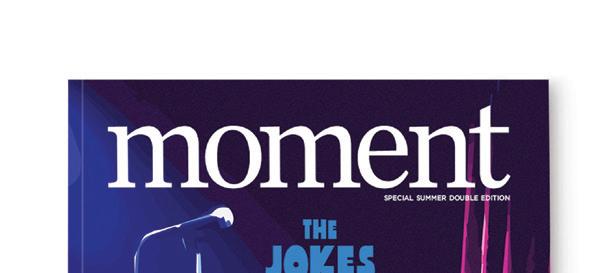
at the discounted rate of $19.95
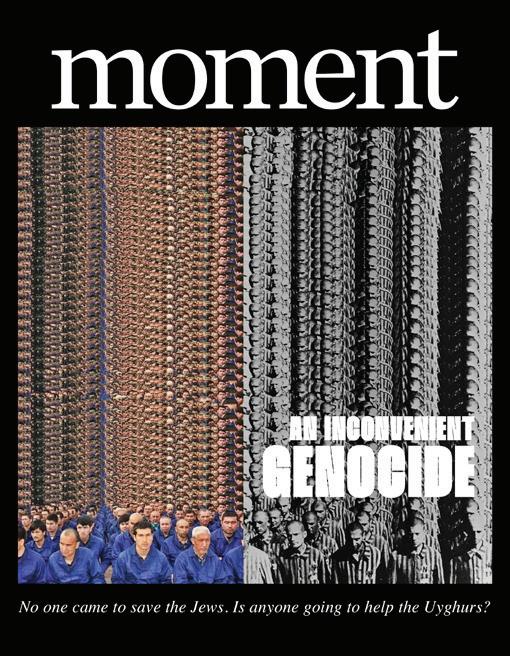
& we will send you this limited edition, Moment signature tote bag for FREE.

NAME
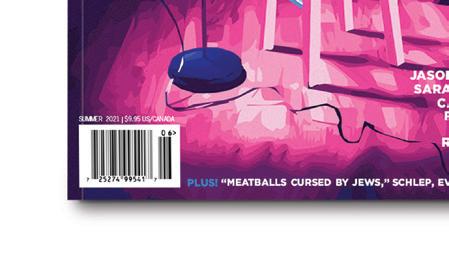
ADDRESS

*Only available for U.S. addresses
CITY STATE / ZIPCODE
EMAIL ADDRESS for digital access and newsletters
PHONE NUMBER
*REQUIRED
BILL ME LATER PAYMENT ENCLOSED FREE TOTE!
- 6 print issues a year - unlimited digital access
To subscribe, visit momentmag.com/subscribe and use the promo code TOTE21 OR Fill out & mail this form to Moment at

4115 WISCONSIN AVE NW, SUITE LL10 WASHINGTON, DC 20016
the Holocaust with people of all ages, but especially our youth and the generations to come. Epstein’s words and Moment Magazine provide a North Star for so many of us at a time when hate and antisemitism are growing exponentially in the United States and around the world. We must all continue to raise awareness about the Holocaust, speak out against hate, encourage others to be upstanders and work for justice. Thank you for all you do for this cause. Allison Silberberg Former mayor of Alexandria, VA
A WRITER OF CLARITY
I just got my hard copy of the issue. As usual, I was very impressed. Nadine Epstein’s opening remarks were fabulous. She is a writer of clarity who has the ability to create pictures for the reader. There are times when I read something she writes and it just brings her points home. My thanks to her for sharing stories of her life with us. Brenda Yanni Park Ridge, NJ
MOMENT DEBATE
ABORTION IS A RELIGIOUS ISSUE
I just finished reading your debate on whether or not banning abortion would curtail Jews’ religious freedom (“Would a Ban on Abortion Curtail Jews’ Religious Freedom?” Winter 2022). Rabbi Shlomo Brody tries to prove that abortion “shouldn’t be framed as a religion-and-state issue,” but I strongly disagree. How could it not be when different religions have different definitions of when life begins? Catholicism says it begins at conception and Judaism says it begins when most of the body has emerged from the womb at birth. So if that’s defined by religion, so is abortion. Nita Polay Levin Edison, NJ
A DISGRACEFUL DISCUSSION
The title of the discussion is as ridiculous as some of the answers. Danya Ruttenberg assumes that having an abortion is always an intrinsic right in Judaism and that “… abortion may be acceptable ‘even for a slim reason, such as to prevent disgrace.’” Any reasonable person would agree that having an abortion is an important decision and should not be done for a “slim reason.” The real disgrace is that “this has been mainstream halacha for a long time.” Similarly, Ruttenberg seems to think that the only way to create “…a world where every child who is born is supported and cared for” is to abort the child rather than change how we as a society raise our children. That is also a disgrace.
I have never heard of the term “abortion justice,” but I do not think that the women who were never born would think they were treated with justice. However, they are not around to make their case. Deborah Prigal Washington, DC
THE CONVERSATION
LEARN ARAMAIC
Moment’s winter edition was worth waiting for. The letters section (“The Conversation,” Winter 2022) provided a lively discussion of issues, but I am puzzled

MOMENT BRAND STUDIO creates powerful content for clients. To learn more, email Ellen Meltzer at emeltzer@momentmag.com.
by a sentence in Maggie Anton’s letter where she writes [discussing the Talmud and barriers to its study]: “...and the latter [progressive Jews] by the barrier of not understanding Aramaic.” Any literature is best understood in the original language. However, between the Steinsaltz and Sefaria (the latter is free) translations, the language barrier is no longer an excuse. In addition, who’s stopping progressives from learning Aramaic? Susanna Levin New Rochelle, NY
in memoriam: faye moskowitz (1930-2022)
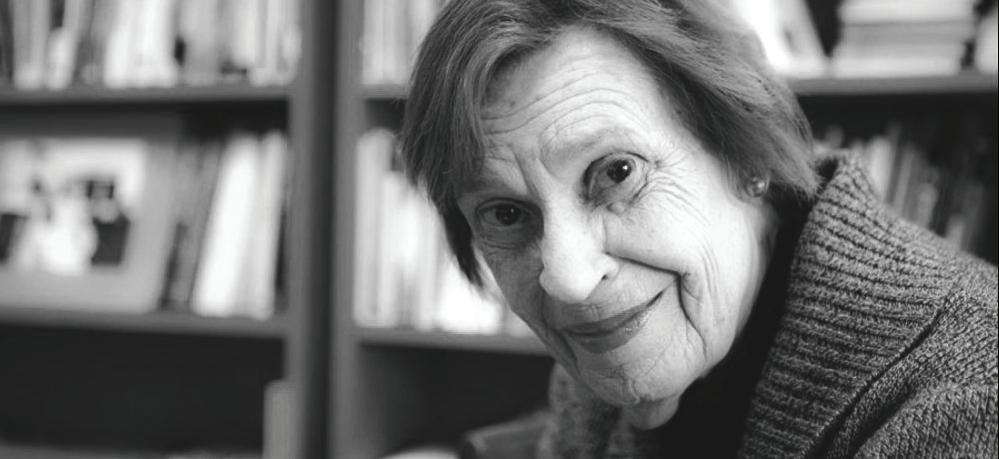
In February we lost Faye Moskowitz, Moment’s longtime poetry editor, who stepped down two years ago after losing her sight. She was a revered writer whose work, including her memoir A Leak in the Heart, inspired generations of writers and was published in Moment, The Washington Post and The New York Times. Faye served as chair of the English Department at George Washington University, where she established and taught the popular Jewish Literature Live! course, which was cited by Time as one of “the hottest seats in class.” A feminist with four children, she shared a warm, welcoming DC home with her husband, Jack. Her big heart enfolded many and showed everyone that there’s always love to share.—Nadine Epstein Visit momentmag.com/faye-moskowitz

JEWISH REVIEW BOOKS JRB is celebrating 12 years!
From fiction to philosophy, and from ancient history to the latest show (or Supreme Court decision), the JRB brings you great writers who review the Jewish world with deep knowledge and ready wit. world with deep knowledge and ready wit.

For special anniversary rates please visit Jewish Culture. Cover to Cover.www.jewishreviewofbooks.com or call 1-877-753-0337
80 Years On: The Wannsee Conference’s meaning and relevance today
by Dr. Matthias Haß, Deputy Director, House of the Wannsee Conference Memorial and Educational Site
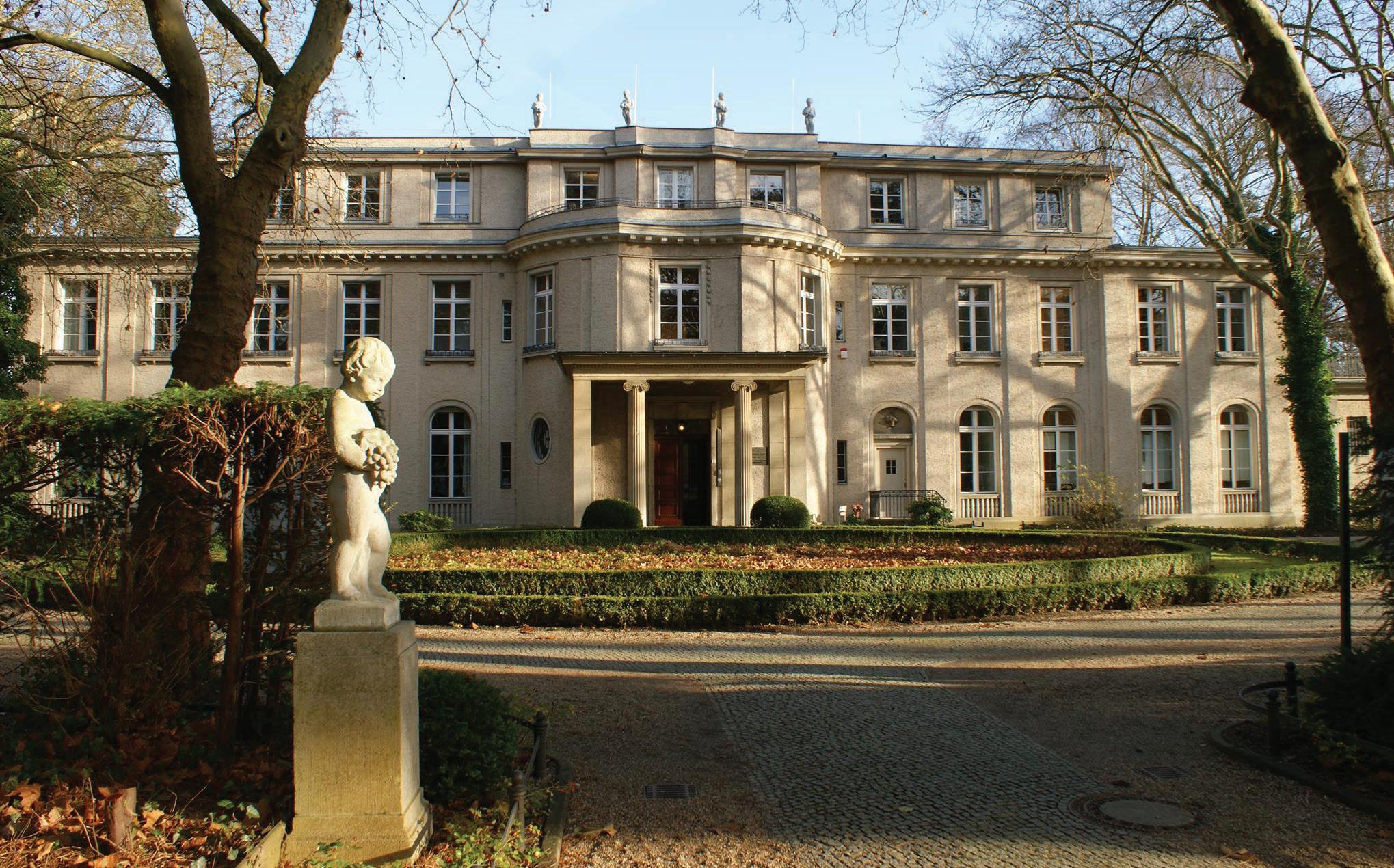
Villa Marlier, site of the Wannsee Conference, Berlin
On January 20, 1942, a meeting took place in a villa on Lake Wannsee in Berlin. Reinhard Heydrich, head of the Reich Security Main Office, had invited 15 officials from the police and the SS, the administration of the occupied territories in Eastern Europe, the Party chancellery and various ministries to the building that was used as a guest house of the SS. There was only one topic to be discussed during the following 90 minutes: The “Final Solution of the Jewish Question in Europe,” the euphemistic code used for what is known today as the plan for deliberately and systematically murdering 11 million European Jews.
Half a year earlier, on July 31st, 1941, Heydrich had been duly authorized by a directive, signed by Hermann Göring, to carry out all material and logistical measures to this end. His objective for the meeting was to assert his leading role in the organization of the genocide, to ensure the cooperation of the other participants and to reiterate what “Final Solution” meant: mass murder.
The Protocol
The protocol of the meeting at Wannsee is a key document in the history of the Holocaust and evidence for the participation of the entire German administration in these crimes. The 15 pages signify the willingness of German state agencies to cooperate in the Holocaust. The participants became accessories to and perpetrators of the genocide, with several agencies and hundreds of thousands of civil servants and police participating in its exact execution.
Adolf Eichmann, responsible for “Jewish Affairs” within Heydrich’s Reich Security Main Office, authored the protocol of the meeting and used coded language to summarize its results, only vaguely outlining the extermination


plans. On page 5, for example, the protocol states:
“With appropriate prior authorisation from the Führer, emigration has now been replaced by evacuation of the
Jews to the East as another possible solution. However, these operations should be regarded only as provisional options, though they are already supplying practical experience of vital importance in view of the coming final solution of the
Jewish question.”
Throughout the document, just like the term “Final Solution”, euphemisms are used to describe the horrific acts those words really imply. The term “evacuation” used here, evades the mention of deportations. The “practical experiences of vital importance” refer to prior operational experiences gained from the mass murder of people with disabilities and the murder of more than 500,000 Jews, including women and children, through the Einsatzgruppen (mobile killing squads).
Pages 7 and 8 of the minutes are crucial in the comprehension of the protocol, as well:
“In the course of the final solution, and under appropriate supervision, the Jews are to be utilised for work in the East in a suitable manner. In large labour columns, separated by sex, the
Jews capable of working will be dispatched to these regions to build roads. In the process, a large portion will undoubtedly drop out through natural reduction.
Those who ultimately should possibly get by will have to be given suitable treatment because they unquestionable represent the most resistant part and therefore constitute a natural selection that, if released, become the germ cell of renewed
Jewish revival.”
Throughout these paragraphs, the outline of the program of murder is clearly being sketched out: killing through hard labor and other “suitable” methods for those who survive forced labor.
Page 6 of the protocol contains a population statistic adding up to an estimated 11 million Jews living in Europe at this time, broken down by countries and territories, making it quite clear what the term “Final Solution” really meant: the planned murder of all European Jews.
The conference’s achieved objects
Within only 90 minutes, Heydrich easily reached two of his three objectives for summoning the Wannsee meeting: His authority had been widely accepted, and he successfully conveyed the true meaning of the term “Final Solution”. Even his third objective - asking for seamless cooperation for a program of mass murder - was not too difficult to attain. The protocol refers to a so-called “Parallelisierung der Linienführung”, i.e. parallelizing of the (planned) procedures, safeguarding the cooperation Heydrich required for the success of the operation of the Europe-wide deportations to death camps in occupied Eastern Europe. The main takeaway of the meeting at Wannsee is the participants’ willingness to partake and cooperate in their murderous project. None of them objected or tried to dodge.
The perpetrators who gathered at Wannsee merged their Nazi convictions, rooted in racial antisemitism, with a sober and objective understanding of their bureaucratic profession to create an effective plan for the genocide of the European Jews. Their only concern was to make sure that their respective fields of work in their organization or department were not negatively affected.

The significance of the Wannsee Conference today
In looking at the specific setting of the meeting at Wannsee in its larger historical context and the attempts to evaluate its significance today, it is helpful to consider a few guiding principles:
One of them is to avoid the reproduction of the perspective of the perpetrators when talking about the Wannsee conference. Ultimately, its significance may only be understood by reflecting upon the Jewish perspective. In addition, it is crucial to use diverse sources that provide a comprehensive understanding of history, including official Nazi documents like the Wannsee protocol, as well as egodocuments of victims and perpetrators like letters, diaries and reports and thereby reflect upon the question of whose history it is. Lastly, the meaning and relevance we give to the meeting at Wannsee today – and thus the meaning we give to the Holocaust in general –


million Soviet prisoners of war had died in German captivity by January 1942. From June 1941 to January 1942, more than 500,000 Jews in the Soviet Union had been shot. Victims’ reports provide additional evidence for the systematic killings before Photos on this page: Exhibits at the Wannsee Conference January 20th, 1942: Szlama Memorial and Education Site. GHWK Berlin, Thomas Bruns. Ber Winer was forced to help unload bodies from is shaped not only by January 20th, trucks that were being used to gas 1942 and the historic context of the people at the killing center in Chelmno Holocaust, but also by the way postwar (Kulmhof) in December and January societies have dealt with and tried to 1942. Escaping from the camp on give meaning to this specific history of January 19th, 1942, he made his way to unprecedented crimes in the decades the Warsaw Ghetto and reported to following the war. the members of the Oyneg Shabes, or the Ringelblum Archive. It is Wannsee as the place of decision the first account of mass killings by making? poison gas that we possess.
Many believe that the conference at The plan to commit mass Wannsee was pivotal to the final decision murder, orchestrated at the Wannsee to kill all European Jews. This is by no conference, was the mere culmination means true. That belief is likely derived of radicalized persecution. It was from a desire to trace the horrific crimes the result of central planning and back to a singular time and place, to regional initiatives, involving hierarchical decision-making structures, hundreds of thousands of members particular individuals and identifiable of the administration, SS, police and actions. The meeting, however, served as a Wehrmacht. coordinating panel by leading bureaucrats debating how to carry out the genocide, Whom does the history of the including the pan-European deportations Holocaust belong to? of Jews that were a central part of their planned murder. Historians still debate whether there is a specific date for the decision to murder all European Jews, considering there is no key document signed by Hitler that provides evidence. Another key question worth considering is who writes history, and who is willing to integrate the history of the Holocaust into their own historical narrative? Nonetheless, evidence can be gathered Jews started to record Nazi crimes from a series of meetings and speeches and Jewish responses during the first confirming that mid-December 1941 years of persecution. By collecting and was probably the time when Hitler, in preserving reports, documents and consultation with Heinrich Himmler and images, they hoped to counter the others, made this decision. National Socialist rendering of history At this time, however, the systematic murder was already underway, well before the participants of the Wannsee Conference convened on January 20th, 1942. After the invasion of Poland in September 1939, tens of thousands of members of the Polish elite had been killed and more than 90,000 people classified as sick or disabled had already been murdered in the Nazi euthanasia program “Aktion T4”. More than two in which Jewish perspectives were completely annihilated. Reports by members of various archives, such as the Ringelblum archive in the Warsaw ghetto, along with testimonies recorded after the liberation and documentary collections compiled by survivors, laid the foundation for the historiography of the Holocaust. In post-war Germany, however, the society of perpetrators expressed little interest in addressing their own responsibility and guilt. German historians only began addressing the history of National Socialism much later. In addition, historiography often analysed the structure and the system of National Socialism, and had less of a focus on the social history of the people, Jews and (non-Jewish) Germans alike. On the level of institutionalized memory, it is worth mentioning that the House of the Wannsee Conference only became a Memorial and Educational Site in 1992, even though the building played such a pivotal role in the crimes of the perpetrators and was an important place in the history of the Holocaust. For a long time, it seemed that documenting this history and marking it as a disturbing example of the involvement of the whole German administration in the unprecedented crime of the Holocaust was not worth the effort. Including the post-war chapters of dealing with the Wannsee Conference in remembrance culture enables us to better understand its meaning and relevance today.
Today, 80 years later, the House of the Wannsee Conference serves as a reminder of what human beings are capable of. A vigorous remembrance culture demands a permanent reflection on the relevance of the history of the Holocaust. In light of rising antisemitism and other forms of discrimination it is obvious that we have not come to an endpoint in dealing with this history.
Visit www.ghwk.de/en for more information.
